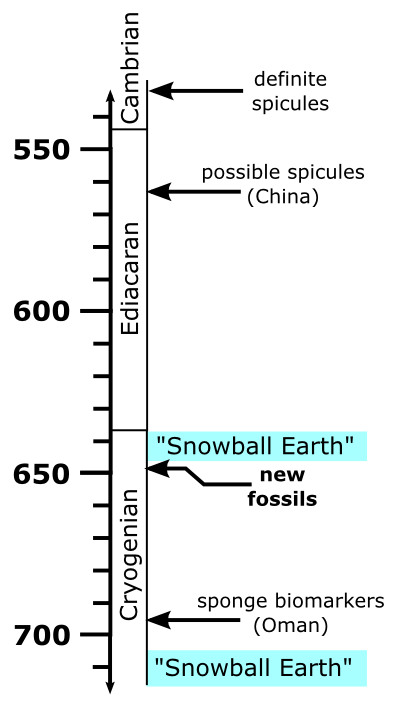![]()
![]() In the debris surrounding 650 million year-old stromatolite reefs in South Australia, Adam Maloof and his group have discovered some rather unusual-looking fossils. They’re all about half a centimetre across, and are composed of red calcite (calcium carbonate), which indicates a biological origin. But they also have a range of apparently quite disparate shapes: as well as the wishbone and figure-of-8 (‘perforated slab’) morphologies shown in the image below, there were also rings and H’s (‘anvils’). In their Nature Geoscience paper, Maloof and his co-authors argue that all of these different forms are in fact cross-sections sliced at different angles through a single type of organism, with a complex three-dimensional shape. To demonstrate this, they took a polished section of the fossil bearing rock, scanned its surface, and traced the outline of any preserved fossil. They then ground off a fraction of a millimetre from the rock face, and scanned it again. Mimicking CT X-ray scans, all of the scanned outlines were then stacked together to reproduce the original shape of the fossilised organism.
In the debris surrounding 650 million year-old stromatolite reefs in South Australia, Adam Maloof and his group have discovered some rather unusual-looking fossils. They’re all about half a centimetre across, and are composed of red calcite (calcium carbonate), which indicates a biological origin. But they also have a range of apparently quite disparate shapes: as well as the wishbone and figure-of-8 (‘perforated slab’) morphologies shown in the image below, there were also rings and H’s (‘anvils’). In their Nature Geoscience paper, Maloof and his co-authors argue that all of these different forms are in fact cross-sections sliced at different angles through a single type of organism, with a complex three-dimensional shape. To demonstrate this, they took a polished section of the fossil bearing rock, scanned its surface, and traced the outline of any preserved fossil. They then ground off a fraction of a millimetre from the rock face, and scanned it again. Mimicking CT X-ray scans, all of the scanned outlines were then stacked together to reproduce the original shape of the fossilised organism.

Top: possible Australian sponge fossil: different shapes are due to the rock surface cutting through different planes of the original organism. Bottom: 3D reconstruction from sequential grinding and scanning, showing interior channel network.
Adam Maloof himself provides a nice, clear explanation of the ‘grind and scan’ method in this video, courtesy of New Scientist.
Adam Maloof describes how the 3D fossil sponge reconstructions were created
The most striking feature revealed by the 3D reconstructions is the network of internal channels that permeates these fossils, which is very reminiscent of the internal water canals of sponges. If this was the case, these would be, by a considerable temporal distance, the oldest animal fossils ever discovered. However, this classification is still tentative: although these fossils do seem to have a sponge-like organisation, they do not clearly possess features common to all other known sponges, living and fossil, such as their quasi-skeletal spicules. But while this claim should be approached with caution (for all I know, Chris Nedin is preparing a rebuttal as I type), if it is confirmed it is not an entirely unexpected discovery. To date, the confirmed physical fossil record of sponges, in the form of possible spicules found in Doushantuo Formation of southern China, stretches back only as far as the late Ediacaran, but molecular clock data suggests that some sponge groups diverged from a presumably spicule-bearing common ancestor at least 200 million years earlier than this, and that, perhaps due to some quirk of Neoproterozoic ocean chemistry, sponges existed during this period but their spicules were not preserved. And just last year sponge biomarkers – carbon compounds formed by the decomposition of organic molecules found only in sponges – were reported from 650-700 million year old rocks in Oman (which we discussed in the Podclast at the time).
So the evidence from numerous sources seems to be converging to suggest that sponges – the first animals – emerged much earlier than the beginning of the Cambrian. In fact, as the timeline in the figure below illustrates, these new fossils from Australia, and the biomarker evidence from Oman, are both found at a rather interesting point in Earth history: the period between the two hypothesised ‘Snowball Earth’ events, when the entire Earth may have completely frozen over for 10-20 million years. And if the molecular clock evidence is accurate, sponges might even have originated before the first proposed Snowball event 700-750 million years ago.

How recent discoveries have pushed the sponge fossil record back almost 100 million years.
This could be considered a paradox: a group of organisms apparently sailing through severe climatic events – a prolonged global deep freeze, followed by an intense supergreenhouse, in the most extreme models of the Snowball Earth – without much trouble at all. This is not the first example, either. Perhaps the ancestors of modern life were tougher critters than we give them credit for – or perhaps the Cryogenian was not quite as hard on Neoproterozoic life as some geologists believe.
Maloof, A., Rose, C., Beach, R., Samuels, B., Calmet, C., Erwin, D., Poirier, G., Yao, N., & Simons, F. (2010). Possible animal-body fossils in pre-Marinoan limestones from South Australia Nature Geoscience DOI: 10.1038/ngeo934



Comments (6)